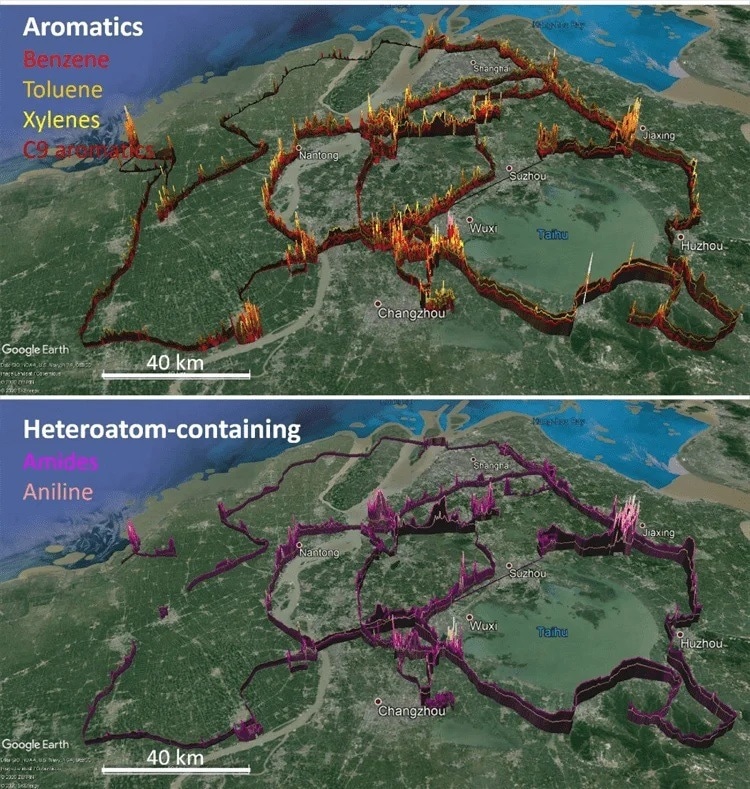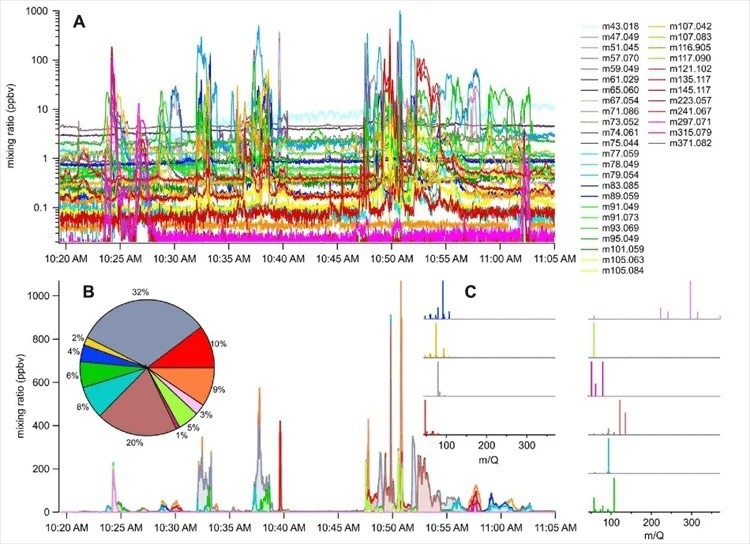Sponsored by TOFWERKReviewed by Aimee MolineuxMar 18 2024
The Vocus PTR-TOF is a powerful, low-power, mobile instrument that facilitates real-time data acquisition when measuring volatile organic compounds (VOCs) in the air. In turn, this produces the kind of data that directly addresses environmental and industrial problems which conventional mass spectrometry fails to do. According to the data acquired using the Vocus PTR-TOF S mobile laboratory, this article discusses the patterns of VOC emissions around a Chinese megacity, including an area close to a petrochemical facility.

Image Credit: TOFWERK
Characterization of VOC Emissions in Urban Areas
The air of dense urban and industrial areas contains abundant volatile organic compounds. VOCs called “air toxics” that include single-ring aromatics can harm the human health of those living and working in such areas. Moreover, residents often deal with unpleasant odors that cause general complaints.
Stringent regulations control the compounds formed through photochemical reactions that pose a risk to the ozone and cause fine particulate aggregation. Increased levels of VOCs can often be traced to industrial sites or residential areas and originate from non-point anthropogenic activities in populated areas.
Industrial operators can better control manufacturing systems if the sources of VOCs are located and identified. Furthermore, this can also lead to a reduction in waste as these sources also indicate leaks and equipment and infrastructure inefficiency. Operators may also be able to meet regulatory standards and ensure compliance by locating VOCs in working environments.
These issues are of key interest in eastern China when considering the proximity and high density of industrial zones to residential areas. For instance, the air quality in Shanghai’s suburban industrial districts negatively impacts the city’s air magnified by the transportation of pollutants from other cities nearby.
Proton-transfer-reaction time-of-flight mass spectrometry (PTR-TOF) is an analytical technique particularly well-suited for mobile monitoring and point-source chemical fingerprinting. The capabilities of the Vocus PTR-TOF instrument platform allow it to measure ambient air directly at a rate of several measurements per second, meaning it is possible to achieve near real-time measurement of the VOC content of an environment.
A high-resolution time-of-flight mass analyzer makes the simultaneous measurement of tens to thousands of VOC species possible; their exact mass-to-charge ratios can distinguish them.
In this study, a Vocus S PTR-TOF set to H3O+ mode was installed in a 3.8-meter-high van. A 1/8′ sampling line pulled in ambient air from ~0.5 meters above the top of the van at a flow rate of ~2 L/min. The sampling line length extended around 3 meters before the Vocus PTR instrument inlet. Zero air and calibration measurements were carried out before and after making the daily rounds in the van. The acquisition rate of the instrument was set to 1 second, and the mass range was calibrated at 1-500 Th.
Detection of VOC Hotspots and Point Sources
The drive path of the mobile Vocus S followed a search pattern across Shanghai during a large multi-institution campaign, passing through urban, rural, and industrial areas. Figure 1 highlights the hotspots the Vocus S identified for particular VOCs in an area encompassing 57,000 km2. The aromatic VOCs in Shanghai can be viewed using Google Earth or LocaSpace Viewer by downloading the data set (.kmz).

Figure 1. Concentrations of selected VOCs above baseline detected in Shanghai. Different VOC are indicated by color. The scale is logarithmic, from 100 ppt to 1.6 ppm; the height and color intensity indicate the mixing ratio. Points with mixing ratio less than 100 ppt are not shown. Image Credit: TOFWERK
Mobile PTR-TOF can also target point sources in a significantly smaller area. For example, a petrochemical plant in Eastern China was used to trace a search pattern through which the Vocus S was driven.
Hundreds of VOCs were detected in this smaller search pattern, detected in mixing ratios ranging from a few parts per trillion (ppt) to those in excess of a part per million (ppm) (Figure 2 A).
Figure 2A displays a subset of the VOCs detected, demonstrating that a large, dynamic range and acquiring many VOC masses simultaneously is necessary. Several isobaric masses are exhibited in Figure 2A and require an instrument with a high mass resolving power to be measured separately.
The mobile detection unit also revealed that the VOC composition mixture varied considerably from point to point. A correlation analysis of VOCs identified the facility's top ten sources of VOC mixtures.
The analysis data from this scenario was then leveraged to quantify how each source contributed to the overall presence of VOCs in the facility (Figure 2). The VOCs shown in Figure 2A were used for the source apportionment analysis. These particular VOCs were chosen because their signal-to-noise ratio is greater than 2.
It is crucial to include even VOCs with reduced mixing ratios in source apportionment analyses. This is because they may be able to discern more clearly between the chemical fingerprints of two sources.
The top ten sources of mixed VOCs are accountable for making up around 92 percent of the total VOC emissions detected at the site. The rest of the emissions identified were found to be almost entirely pure benzene.
The various sources found were associated with refinement and storage equipment in various facility areas. It was possible to locate each site of each VOC source by simply plotting the VOCs measured on a map (Figure 3). Overall, this particular site was covered using a mobile laboratory, which delivered results on the presence of VOCs in less than an hour.

Figure 2. A. An overwhelming variety of VOCs observed at the petrochemical industrial park, with concentrations ranging from 10 ppt to 1000 ppb. B. Factor analysis of the observed VOCs reveals a smaller number of sources, each with a distinct VOC composition. The pie chart shows the contribution of each source to total VOC. C. Mass spectra of the sources containing mixed VOCs. Image Credit: TOFWERK

Figure 3. Locations of compositionally-distinct VOC plumes at the petrochemical facility. Image Credit: TOFWERK
Acknowledgments
Produced from materials originally authored by Wen Tan, Abigail Koss, Liang Zhu from TOFWERK.

This information has been sourced, reviewed and adapted from materials provided by TOFWERK.
For more information on this source, please visit TOFWERK.